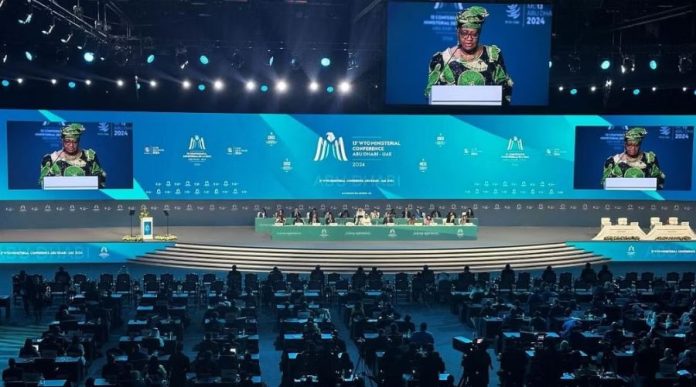Currently, World Trade Organization is holding its 13th Ministerial Conference in Abu Dhabi, UAE. Speaking at a session on sustainable development and policy space for industrialization, Commerce Secretary Sunil Barthwal raised an important issue: unilateral protectionism that some countries pursue in international trade under the guise of environmental protection. Clearly, his statement signals towards the carbon tax imposed by EU. He argued that developing countries need flexibility in WTO agreements to overcome constraints in their industrialization.
At another session on “Trade and Inclusion”, he warned WTO members against mixing non-trade issues with WTO rules, as this could lead to greater trade fragmentation. He said, “Bringing issues like gender and MSMEs into the realm of WTO discussions was not practical because these issues were already being discussed in other relevant international organizations.” He also stated that the issue of inclusion can be better addressed through targeted national measures, which do not fall within the domain of international trade relations. The Commerce Secretary mentioned that some developed countries are using non-trade issues to put up barriers and provide trade-distortive subsidies. He called this approach “unilateralism” and said that it would have a negative spillover effect on the trade interests of developing countries.
He also underscored India’s progressive measures in the inclusion of women and MSMEs through Digital Public Infrastructure.
His remarks become significant as India has already raised concerns over the EU’s carbon tax, which India finds harmful to its interests. The European Union’s Carbon Border Adjustment Mechanism (CBAM), or simply “carbon tax,” came into discussions while a related legislation was under consideration.
What is Carbon tax?
After a legislation was passed in May last year, the EU announced it would impose a carbon tax on imports, coming into effect from 2026. The law regarding deforestation also complicates the situation, affecting products such as coffee, among others.
In 2005, the EU established a cap-and-trade system. Under this system, industries operating in Europe and emitting carbon compounds were required to obtain an allowance by paying for the environmental damage they caused. However, due to practical trade concerns, the EU failed to implement it as is. Instead, it had to give waivers, fearing that levying taxes could discourage industries from operating in Europe and eventually relocate to other countries with less stringent environmental constraints. Now, as the EU phases out free allowances, it is simultaneously implementing a carbon tax on imports.
The EU has devised a mechanism to apply a carbon tax that aligns with the Cap-and-Trade system. Simply put, a company operating outside Europe will have to pay the same amount for a particular volume of emissions during its manufacturing as a European producer would pay under the Cap-and-Trade system for the same volume of emissions.
Clearly, the aim is to address the limitations of operating the Cap-and-Trade system alone. The CBAM will translate into a 20-35% tax on select imports into the EU starting January 1, 2026.
India’s Stand
As a developing country, India primarily exports commodities like iron ore pellets, steel, and coffee. Many of these exports fall under the new CBAM regime, making it challenging for India. Reports suggest that the EU procures about 26.6% of India’s total exports of iron ore pellets, aluminum, and steel. In FY23, India’s exports of these goods to the EU amounted to $7.4 billion. Similarly, coffee, leather hides, and paperboard exports to the EU stand at around $1.4 billion annually.
Therefore, India has been against levying such a tax since the beginning. During the ongoing WTO Ministerial Conference, India argued that these types of subsidies effectively nullify the carefully negotiated balance of rights and obligations under specialized multilateral environmental agreements (MEAs). India pointed out that these agreements provide flexibility for developing countries to pursue their Net Zero targets and implement the principle of Common but Differentiated Responsibilities and Respective Capabilities (CBDR-RC) according to their specific circumstances. Imposing such taxes and mainstreaming them in the WTO would nullify these flexibilities and render previous steps obsolete.
Challenges
Arguments in favour of the carbon tax primarily come from developed countries. They see it optimistically, believing that industries that shift to developing countries due to relaxed environmental standards will be deterred from doing so once they know their products will be taxed. Additionally, they believe it would be easier to address the competitiveness of products from developing countries.
However, the primary justification for the tax is environmental concern. The EU argues that it will encourage countries outside the bloc to take more aggressive measures for environmental conservation. Even the free allowance in Cap-and-Trade system was also continued arguing that if industries shift to other countries, citing tax compulsion, the overall global emission would not decrease. But with due consideration it must be noted that international trade accounts for only about 20-30% of global greenhouse gas emissions. Also, the countries like US, China, Russia and even EU itself are the highest per capita emitters of greenhouse gases despite having tightened rules and norms. While US has highest emission of 14,7 tonnes, EU’s per capita emission stands at 6 tonnes. On the opposite, India’s per capita emission is merely 2 tonnes, even less than the global average of 4.7 tonnes.
Still India is going to be adversely impacted because despite its low emission, its highest emitting sectors are cement, iron, steel among others, which it aggressively exports to EU. So, the concept of carbon tax may be guided by anything but global greenhouse emission because, it could give a free ride to the countries that sell high standard products but are largest emitters.

